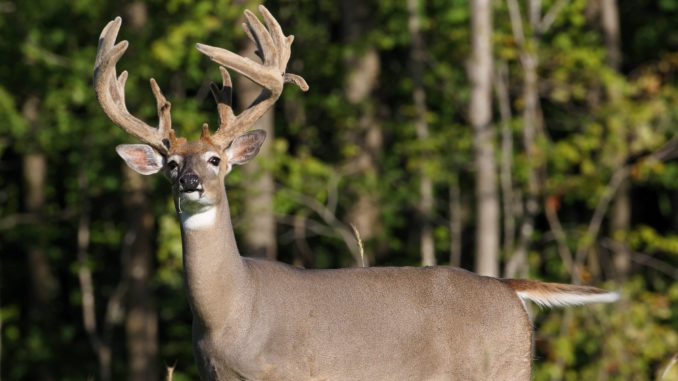
Research indicates that no single supplemental forage variety can meet all the needs of whitetailed deer year-round. Additionally, there is no one plant suited for every soil type and growing condition found across the state. However, planting compatible combinations of forages can help to overcome the shortcomings of individual varieties that are planted alone.
“Mixed-forage food plots provide wildlife with more diverse forages and cover, and often are used by more wildlife species than a single crop plot,” said Bronson Strickland, assistant extension wildlife professor at Mississippi State University. “Furthermore, mixed-forage food plots can provide year-round use on smaller acreage, and if one crop doesn’t make, a second or third crop probably will produce.”
Many deer biologists and managers recommend clover/grass combinations for cool-season plantings. Being a legume, clover is very nutritious (20 to 30 percent protein), and has the ability to remove or “fix” atmospheric nitrogen in a form that the companion plants can utilize. The nitrogen is removed from the atmosphere by rhizobia bacteria that live in nodules on the legume roots and convert to ammonium to be taken up by the surrounding plants.
Clover must be properly inoculated with a plant-specific packet of inoculum-containing bacteria in order for it to grow properly. Inoculating clover seeds increases foliage and seed production, decreases fertilizer cost and builds soil quality. Many clover seeds are now available pre-inoculated. Just remember not to allow fertilizer to come in contact with inoculated seed, since the salts in the fertilizer may kill the live bacteria.
The grasses in this forage/clover combination benefit the clover seedlings by protecting them from drought and overgrazing. The grasses also efficiently utilize the nitrogen produced by the clover that would otherwise be taken up by weeds in the food plot.
Most cool-season plantings are made from September through October, depending on soil moisture and other local conditions. Caution should be used with early plantings as they run a higher risk of damage from fall army worms.
Winter grasses including ryegrass, wheat and oats produce quality forage that attract deer and provide them with needed nutrition through the winter months. These winter grasses are good forage producers that deer utilize from November through April.
Oats are usually the most preferred grass in early fall, but may be winter killed more easily than the other grasses. Both wheat and ryegrass produce about the same quantity and quality of forage. However, unless grazed heavily, wheat quickly loses its palatability because of plant maturity. Ryegrass is more shade tolerant than wheat or oats, so it is the best choice for small food plots in forested areas.
A variety of clovers are very good cool-season food-plot plantings. Clovers provide high protein forage that deer use from November through July. Their use is particularly high in March, April and May when diet is important for antler growth and reproduction.
The most common annual clovers that best fit these mixtures include crimson, arrowleaf, berseem, subterranean and ball. More perennial types include red clover and ladino-type white clover. The red clover provides additional spring growth, while the white clover remains as a perennial in the food plot where light and moisture are adequate.
“The characteristics of clover species differ with some being more tolerant of certain climatic conditions, soil conditions and management regimes than others,” said forage specialist Rocky Lemus. “All clovers are not created equal, and adding clovers to a cool-season food plot requires three major management challenges.
“The first is to ensure that the pH has been adjusted well before planting. Sample soils at least six months ahead of the planting date, and apply recommended lime so that fields will be ready for planting in the fall.
“Legumes need a higher pH (5.8 to 7) than grasses do, in part so the bacteria that fix the nitrogen can function effectively. Most clovers do poorly in acidic soils. Liming the soil to a pH of at least 5.8 will help ensure a good stand of clover. It is not recommended to attempt clover establishment until the soil pH is within the prescribed range for a specific variety.
“The second challenge is to ensure that the soil contains adequate levels of potassium and phosphorus for successful establishment and persistence.
“The third challenge is to control broadleaf weeds before seeding clover in food plots. Once clovers are seeded in food plots, control of broadleaf weeds ranges from very difficult to impossible.”
Strickland warned against exceeding the adjusted seeding rates. Overplanting within mixtures wastes money and reduces forage production because of plant competition and overcrowding.
Regardless of the types of clovers you plan to utilize or the mixtures of cool-season grasses you intend to blend them with, careful planning is critical. If you don’t already keep a food-plot log book, you should. Accurate food-plot records will help you determine which food plots, forage types, seed mixtures, seed rates and planting methods succeeded or failed in previous years.
Especially when dealing with large numbers of food plots on a particular property, these records will help reduce the chance of repeating any mistakes made last year and remind you about what proved successful. Also, a food plot log book will help you keep up with soil-testing results and lime and fertilizer requirements for each individual food plot.
When taking your soil samples, carry along a hand-held GPS unit. This will allow you to quickly calculate the acreage in each food plot without having to guess. It is important to have an accurate acreage when determining lime, fertilizer and seeding rates.
Editor’s Note: This story appears as part of a feature in Louisiana Sportsman’s August issue now on newsstands. To ensure you don’t miss any information-packed issues of the magazine, click here to have each issue delivered right to your mail box.


